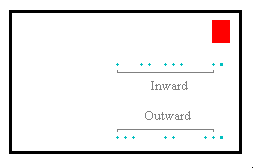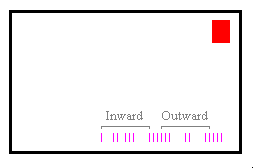In its original form, this system consists of two rows of blue dots on the envelope. Each row contains 13 dot positions plus an index dot at the right hand end; the dots are a quarter of an inch apart with the index dot about three-quarters of an inch from the right hand edge of the envelope. The lower row (about half an inch above the bottom edge) represents the outward code, and the upper row (two inches higher) the inward code.

A more modern form consists of a row of vertical pink bars, often made of a dozen or so dots that are touching or almost so. Each bar is a quarter of an inch high and the same distance above the bottom edge of the envelope; there are 8 bars to the inch with the rightmost bar about an inch from the right hand edge of the envelope. From left to right the pattern of bars is:

The 13 bits of each code represent a number from 0 to 4095. The leftmost bit is a parity check (there should be an odd number of dots or bars), while the remaining 12 have values, from left to right, of 32, 16, 8, 4, 2, 1, 2048, 1024, 512, 256, 128, and 64. Thus the above patterns represent the outward code 2289 and inward code 3149. Note that codes 1365 and 2730 are represented by alternating patterns, and are reserved for testing.
The irregularities of the outward codes means that I do not yet fully understand the encoding. It would appear that each of the 124 areas is given a base number, and then the district number is added to that. Thus the base for CB is 2286, and so CB1 is coded as 2287, CB2 as 2288, and so on. However, this might well not be the full explanation, and it doesn't explain how sub-districts are handled.
The following table lists the deduced base values for each area checked, and those districts used to deduce them. More data is needed.
| Area | Base | Districts checked |
|---|---|---|
| CB | 2286 | 1, 3 |
| IM | 2693 | 4 |
| ME | 4066 | 18 |
| N | 1903 | 1, 3 |
| NP | 445 | 44 |
| NR | 2982 | 30 |
| RG | 3589 | 14 |
| SN | 1969 | 7 |
| W | 2018 | 4 |
| WD | 2309 | 1, 2 |
In addition, it would appear that low-numbered codes based on the post town are used where the postcode was not visible. Examples seen are:
| Code | Post town |
|---|---|
| 529 | Laxey, IOM |
| 705 | Cambridge |
To represent the inward code, each character is given a value and these three values are added together. Because of the two reserved codes, the value of the digit is expressed as a value for the range of the code.
| Range | 0AA to 0ZZ |
1AA to 1ZZ |
2AA to 2ZZ |
3AA to 3ZZ |
4AA to 4FZ |
4GA to 4ZZ |
5AA to 5ZZ |
6AA to 6ZZ |
7AA to 7SE |
7SF to 7ZZ |
8AA to 8ZZ |
9AA to 9ZZ |
|---|---|---|---|---|---|---|---|---|---|---|---|---|
| Value | 3667 | 65 | 465 | 865 | 1265 | 1266 | 1666 | 2066 | 2466 | 2467 | 2867 | 3267 |
| A | B | D | E | F | G | H | J | L | N | |
| first | 0 | 20 | 40 | 60 | 80 | 100 | 120 | 140 | 160 | 180 |
| last | 0 | 1 | 2 | 3 | 4 | 5 | 6 | 7 | 8 | 9 |
| P | Q | R | S | T | U | W | X | Y | Z | |
| first | 200 | 220 | 240 | 260 | 280 | 300 | 320 | 340 | 360 | 380 |
| last | 10 | 11 | 12 | 13 | 14 | 15 | 16 | 17 | 18 | 19 |
For example, the above inward code is 3149. This is 2867+280+2, and so represents 8TD.
 UK Postcodes or
UK Postcodes or
 the Postcodes index.
the Postcodes index.
 Back to Clive's home page.
Back to Clive's home page.